| Srl | Item |
| 1 |
ID:
102236
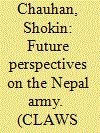

|
|
|
| 2 |
ID:
116016
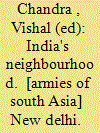

|
|
|
|
|
| Publication |
New Delhi, Pentagon Press, 2013.
|
| Description |
xxvi,167p.
|
| Standard Number |
9788182747067
|
|
|
|
|
|
|
|
|
|
|
|
Copies: C:2/I:0,R:0,Q:0
Circulation
| Accession# | Call# | Current Location | Status | Policy | Location |
| 056962 | 355.310954/CHA 056962 | Main | On Shelf | General | |
| 056963 | 355.310954/CHA 056963 | Main | On Shelf | General | |
|
|
|
|
| 3 |
ID:
167697
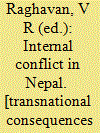

|
|
|
|
|
| Publication |
New Delhi, Vij Books India Pvt Ltd, 2011.
|
| Description |
xii, 272p.hbk
|
| Standard Number |
9789380177649
|
|
|
|
|
|
|
|
|
|
|
|
Copies: C:1/I:0,R:0,Q:0
Circulation
| Accession# | Call# | Current Location | Status | Policy | Location |
| 059704 | 954.96/RAG 059704 | Main | On Shelf | General | |
|
|
|
|
| 4 |
ID:
084293
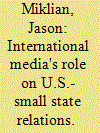

|
|
|
|
|
| Publication |
2008.
|
| Summary/Abstract |
U.S. foreign policy relationships toward states with which it assumes limited geostrategic significance are often simplistic in design and misguided in their calculations because of the disproportionate weight given to the limited information from which policy is synthesized. International media outlets exacerbate this problem by underreporting, improperly framing stories, combining distinct events, piggybacking upon their domestic counterparts, encouraging simplifications, and misrepresenting reality on the ground. Recent U.S.-Nepal policy is a prototypical example, as a complex civil war with multiple actors was reduced in the eyes of U.S. policy makers to a simplistic terrorist uprising and treated as such until additional media attention propagated a substantial re-examination of policy. Although this case is more explanatory than predictive, this basic framework may enlighten a more nuanced overall understanding of U.S.-small state relations.
|
|
|
|
|
|
|
|
|
|
|
|
|
|
|
|
| 5 |
ID:
111669
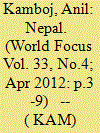

|
|
|
| 6 |
ID:
126289
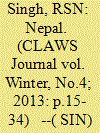

|
|
|
| 7 |
ID:
112361


|
|
|
| 8 |
ID:
111205


|
|
|
| 9 |
ID:
112349
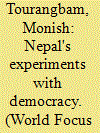

|
|
|
| 10 |
ID:
086735


|
|
|
|
|
| Publication |
2009.
|
| Summary/Abstract |
Events that take place in the springtime, particularly in April, have generally shaped contemporary Nepali politics. If the People's Movement in 2006 ensured that King Gyanendra had to give way and the people reigned supreme, in April 2008 elections to the Constituent Assembly threw up an unexpected result, leaving the Maoists with the single largest vote share. This spring, Nepal faces a multitude of challenges, from pushing ahead with the writing of the constitution and the peace process in general, to ensuring a semblance of governance and strengthening of democratic institutions
|
|
|
|
|
|
|
|
|
|
|
|
|
|
|
|
| 11 |
ID:
107130


|
|
|
| 12 |
ID:
152018
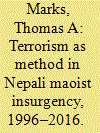

|
|
|
|
|
| Summary/Abstract |
During the period 1996–2006, the Communist Party of Nepal (Maoist) waged overt people’s war to seize state power and institute a new order that realized the party’s understanding of ‘New Democracy’ as posited by Mao Tse-tung. Contextual shifts led to a crucial strategic turning point in September 2005, when the Maoists agreed to a united front with estranged legal parties to oust the monarchy and establish a republic. Though touted as acceptance of political reintegration, the move was tactical rather than strategic. The party had no intention of supporting a parliamentary version of democracy and thus, 2006–2016, engaged in a covert effort to seize power. Central to this effort was the paramilitary Young Communist League (YCL), the members of which responded to inflammatory party verbiage and exhortations with attacks upon rival political actors. These attacks, academically and legally, were terrorism and offered a salient illustration of intra-state unrestricted warfare. Ultimately, organizational, national, and regional circumstances caused the main Maoist movement to move decisively away from its covert approach. By that time, however, radical splinters had embraced the use of terrorism against rival political actors, creating a situation whereby local politics is yet a dangerous endeavor in certain areas and at certain times.
|
|
|
|
|
|
|
|
|
|
|
|
|
|
|
|